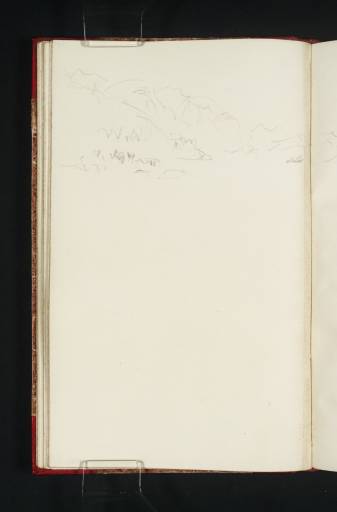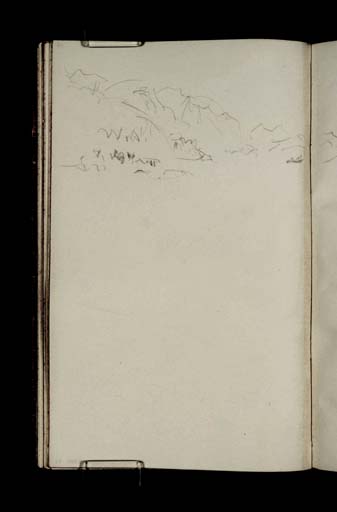J.M.W. Turner
>
1830-35 Annual tourist
>
Scotland 1831
>
Staffa Sketchbook
>
Artwork
Joseph Mallord William Turner The Eastern Cliffs of Staffa 1831
Image 1 of 2
Joseph Mallord William Turner,
The Eastern Cliffs of Staffa
1831
Joseph Mallord William Turner 1775–1851
Folio 24 Verso:
The Eastern Cliffs of Staffa 1831
D26788
Turner Bequest CCLXXIII 24a
Turner Bequest CCLXXIII 24a
Pencil on white wove paper, 186 x 116 mm
Accepted by the nation as part of the Turner Bequest 1856
References
1909
A.J. Finberg, A Complete Inventory of the Drawings of the Turner Bequest, London 1909, vol.II, p.876, CCLXXIII 24a, as ‘Mountains.’.
This sketch (continuing at the right on folio 25; D26789) has been identified as a view along the eastern cliffs of the Isle of Staffa, looking towards the island of Geometra and the hills of Mull to the north. The sketch was made from the landing place at the south of the island near Fingal’s Cave. David Wallace-Hadrill and Janet Carolan suggest that the small boat that brought Turner and other passengers from the Maid of Morven steamboat to the landing may be visible in this sketch, perhaps represented by the dark marks at the left of the sketch,1 though these are ambiguous and may represent people.
Wallace-Hadrill and Carolan suggest that ‘it is perhaps from approximately this south-easterly viewpoint that Turner envisaged the cliffs of Staffa which rise dimly from the left side of the oil’2 Staffa, Fingal’s Cave exhibited 1832 (Yale Center for British Art, Paul Mellon Collection).3 In the painting, however, the island and cave are seen from the south-west, looking north-east to the southern point of the islands with the cave entrance at the right. Turner did not make a sketch of this view of the island. However, there was a model for this view in William Daniell’s aquatint, Entrance to Fingal’s Cave, Staffa 1814–25 (Tate T02795), which Turner is likely to have been familiar with. Like Daniell, Turner even included a seagull and several shags in the painting. Incidentally, the position of the sun in the oil painting is in the east, meaning that it should, if we are sticklers for such things, be a sunrise rather than a sunset as John Gage suggested.4 However, a setting sun is what Turner saw – ‘The sun getting close to the horizon, burst through the rain-cloud’ –5 and is what fits best with the theme of the painting. As Wallace-Hadrill and Carolan put it, ‘This is no more a topographical painting than is the Great Western Railway painting, “Rain Steam and Speed”. This is a painting of cloud, waves and rock daunting a little steamboat, initially stimulated by Turner’s experience of Staffa.’6
For a full list of Turner’s sketches of the Isle of Staffa and Fingal’s Cave, see folio 40 (D26817).
Thomas Ardill
March 2010
David Wallace-Hadrill and Janet Carolan, ‘Turner on Mull and Staffa’, [circa 1991], Tate catalogue files, [Folio 7].
Martin Butlin and Evelyn Joll, The Paintings of J.M.W. Turner, revised ed., New Haven and London 1984, pp.189–9, no.198.
Kenneth Clark, Michael Kitson, John Gage and others, La Peinture romantique anglaise et les Préraphaélites, exhibition catalogue, Petit Palais, Paris 1972, p.185 under cat.265.
How to cite
Thomas Ardill, ‘The Eastern Cliffs of Staffa 1831 by Joseph Mallord William Turner’, catalogue entry, March 2010, in David Blayney Brown (ed.), J.M.W. Turner: Sketchbooks, Drawings and Watercolours, Tate Research Publication, December 2012, https://www


